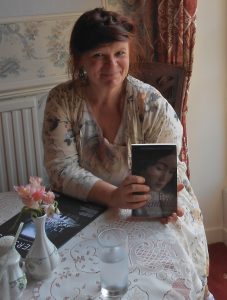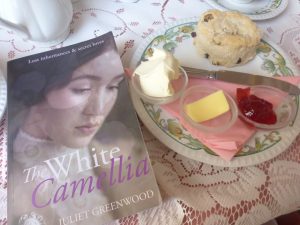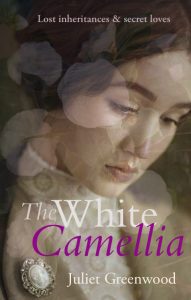Writing An Unsympathetic Heroine
 Like Jane Austen with Emma, I set out for one of my heroines of The White Camellia to be decidedly unsympathetic. She had to be. You see, because while the younger heroine, Bea, has obstacles to overcome, when her family is ruined, and their beautiful Cornish home of Tressillion House lost, the older heroine, Sybil, is the very cause of that ruin.
Like Jane Austen with Emma, I set out for one of my heroines of The White Camellia to be decidedly unsympathetic. She had to be. You see, because while the younger heroine, Bea, has obstacles to overcome, when her family is ruined, and their beautiful Cornish home of Tressillion House lost, the older heroine, Sybil, is the very cause of that ruin.
So while in London Bea struggles to escape an arranged marriage and find love, and fulfilment as a photojournalist, Sybil completes the revenge she set in motion many years ago, as she takes over Tressillion House.
Of course, nothing is ever that simple, and revenge itself is never that simple. Part of my inspiration for the story was Barbara Taylor Bradford’s ‘A Woman of Substance’. I love the book, and for years I’ve being playing with ideas in my mind. Supposing, having repaid past wrongs, and gained the house, the heroine didn’t tear it down and obliterate it. Suppose she lived there, gradually, against her will, falling in love with the house and garden she had once loathed, and in doing so having to come to terms with the darker side of herself.
Because, of course, no heroine is entirely unsympathetic. Jane Austen’s Emma is exasperating in her naivity, her meddling and her snobbery, but you can see why she is as she is, and her patience and thoughtfulness towards her impossible father makes her foibles loveable, despite Jane Austen setting out to write a heroine no one would like.
I found it much the same when I was writing Sybil. At first, I didn’t want to know her, to get inside her skin. Bea came so much more fluently, even in her darkest hours, but with Sybil I struggled. Looking back, I think I knew that once I did live inside her skin, and see through her eyes, it was impossible not to understand her.
There are always reasons behind people’s actions, however terrible the consequences, and I’m sure we’ve all dreamed of paying someone back in the face of injustice, even if we’d never carry it out in reality. Much of Sybil’s story is her search to forgive herself for what she has done, and find some kind of peace. I have a feeling that I was afraid that seeing through Sybil’s eyes might explode my carefully constructed story.
 It certainly changed the novel – but not the central mystery. It was one of the hardest things I’ve ever done, but, with the help of my inestimably astute editor, Janet Thomas, I tackled this stretching of my story-telling skills, and, in the end, I loved the process.
It certainly changed the novel – but not the central mystery. It was one of the hardest things I’ve ever done, but, with the help of my inestimably astute editor, Janet Thomas, I tackled this stretching of my story-telling skills, and, in the end, I loved the process.
So many heroines are defined by their relationships, and by the difficulties and compromises of family that women face, so it was a challenge to write a woman who has become successful, rich and independent, in the face of impossible odds and entirely on her own terms. A woman in control of her life, at a time when most women had very few choices, and who has achieved her ambitions. Yet, at the same time, a woman haunted by her own actions, and the moral choices she has made.
Seeing the story through her eyes, and her inner turmoil, ensured that, in the end, Sybil did not become an entirely unsympathetic heroine. Prickly, defensive and exasperatingly stubborn, maybe, but also a woman who has to come to terms with what it is to be human, with all the shades of good and evil, and the unintended consequences of action taken in the heat of the moment. We all have our darker sides, and very few human beings are completely, irredeemably, wicked. I found I learnt quite a bit about myself when writing Sybil, as well as developing my character-writing skills.
Then, of course, came the additional challenge of finding a hero who would understand, and love, Sybil simply for who she is. But I rather think I should leave that to Sybil to tell ….
 The White Camellia
The White Camellia
1909 Cornwall. The great Tressillion family is ruined. As Bea is forced to leave Tressillion House, self-made businesswoman Sybil moves in. In a world where the old rules are starting to break down, this one choice will change both their lives forever…
Sybil buys the abandoned great house even though she is tempted to tear it down. The village sees only a rich American hotel-owner. Nobody recognises the young girl who left years ago with nothing but a desperate need for revenge. Buying the house is her triumph — but now what? As the house casts its spell over her, as she starts to make friends in the village despite herself, will she be able to build a new life here, or will her old ghosts and hatred always rule her heart?
Bea finds herself in London, responsible for her mother and sister’s security. Her only hope is to marry Jonathon, the new heir. He seems kind, but is he hiding something? Desperate for options, she stumbles into the White Camellia tearoom, a gathering place for the growing suffrage movement. For Bea it’s life-changing, introducing her to new friends, new ideas, maybe love, maybe even a chance to work and support herself. But it’s dangerous, risking arrest or worse. Can she follow her dreams without bringing yet more scandal on her family?
When those very dangers send the White Camellia friends back to Cornwall, Bea and Sybil must finally confront each other. Will long buried family secrets on both sides now destroy them both?
Buy The White Camellia on Amazon:
—
Juliet Greenwood is a UK historical novelist published in Wales by Honno Press. Her books are set in Cornwall, London and Wales in Victorian and Edwardian times, and follow the lives of independently-minded women struggling to find freedom and self-fulfillment. ‘The White Camellia’ will be published in September 2016, and her two previous historical novels for Honno have reached #4 and #5 in the UK Amazon Kindle store. ‘Eden’s Garden’ was a finalist for ‘The People’s Book Prize’. ‘We That are Left’ was completed with a Literature Wales Writers’ Bursary, and was Welsh Book of the month for Waterstones Wales, The Welsh Books Council and the National Museum of Wales. It was also chosen by the ‘Country Wives’ website as one of their top ten ‘riveting reads’ of 2014, was one of the top ten reads of the year for the ‘Word by Word’ blog, and a Netmums top summer read for 2014.
One of Juliet’s grandmothers was a nail-maker in Lye, near Birmingham, while the other worked as a cook in a big country house, leaving Juliet with a passion for history, and in particular for the experiences of women, which are often overlooked or forgotten. Juliet trained as a photographer when working in London, before returning to live in a traditional cottage in Snowdonia, in beautiful North Wales. She loves gardening and walking, and trying out old recipes her grandmothers might have used, along with exploring the upstairs and downstairs of old country houses.
Website: http://www.julietgreenwood.co.uk/
Blog: http://julietgreenwoodauthor.wordpress.com/
Facebook: https://www.facebook.com/juliet.greenwood
Twitter: @julietgreenwood
Category: On Writing






























